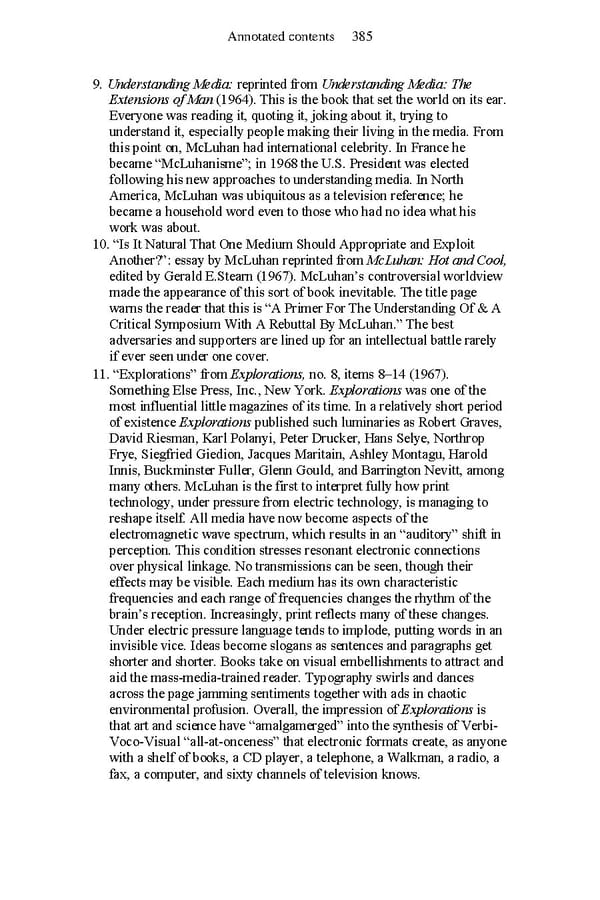Annotated contents 385 9. Understanding Media: reprinted from Understanding Media: The Extensions of Man (1964). This is the book that set the world on its ear. Everyone was reading it, quoting it, joking about it, trying to understand it, especially people making their living in the media. From this point on, McLuhan had international celebrity. In France he became “McLuhanisme”; in 1968 the U.S. President was elected following his new approaches to understanding media. In North America, McLuhan was ubiquitous as a television reference; he became a household word even to those who had no idea what his work was about. 10. “Is It Natural That One Medium Should Appropriate and Exploit Another?”: essay by McLuhan reprinted from McLuhan: Hot and Cool, edited by Gerald E.Stearn (1967). McLuhan’s controversial worldview made the appearance of this sort of book inevitable. The title page warns the reader that this is “A Primer For The Understanding Of & A Critical Symposium With A Rebuttal By McLuhan.” The best adversaries and supporters are lined up for an intellectual battle rarely if ever seen under one cover. 11. “Explorations” from Explorations, no. 8, items 8–14 (1967). Something Else Press, Inc., New York. Explorations was one of the most influential little magazines of its time. In a relatively short period of existence Explorations published such luminaries as Robert Graves, David Riesman, Karl Polanyi, Peter Drucker, Hans Selye, Northrop Frye, Siegfried Giedion, Jacques Maritain, Ashley Montagu, Harold Innis, Buckminster Fuller, Glenn Gould, and Barrington Nevitt, among many others. McLuhan is the first to interpret fully how print technology, under pressure from electric technology, is managing to reshape itself. All media have now become aspects of the electromagnetic wave spectrum, which results in an “auditory” shift in perception. This condition stresses resonant electronic connections over physical linkage. No transmissions can be seen, though their effects may be visible. Each medium has its own characteristic frequencies and each range of frequencies changes the rhythm of the brain’s reception. Increasingly, print reflects many of these changes. Under electric pressure language tends to implode, putting words in an invisible vice. Ideas become slogans as sentences and paragraphs get shorter and shorter. Books take on visual embellishments to attract and aid the mass-media-trained reader. Typography swirls and dances across the page jamming sentiments together with ads in chaotic environmental profusion. Overall, the impression of Explorations is that art and science have “amalgamerged” into the synthesis of Verbi- Voco-Visual “all-at-onceness” that electronic formats create, as anyone with a shelf of books, a CD player, a telephone, a Walkman, a radio, a fax, a computer, and sixty channels of television knows.
 Essential McLuhan Page 391 Page 393
Essential McLuhan Page 391 Page 393